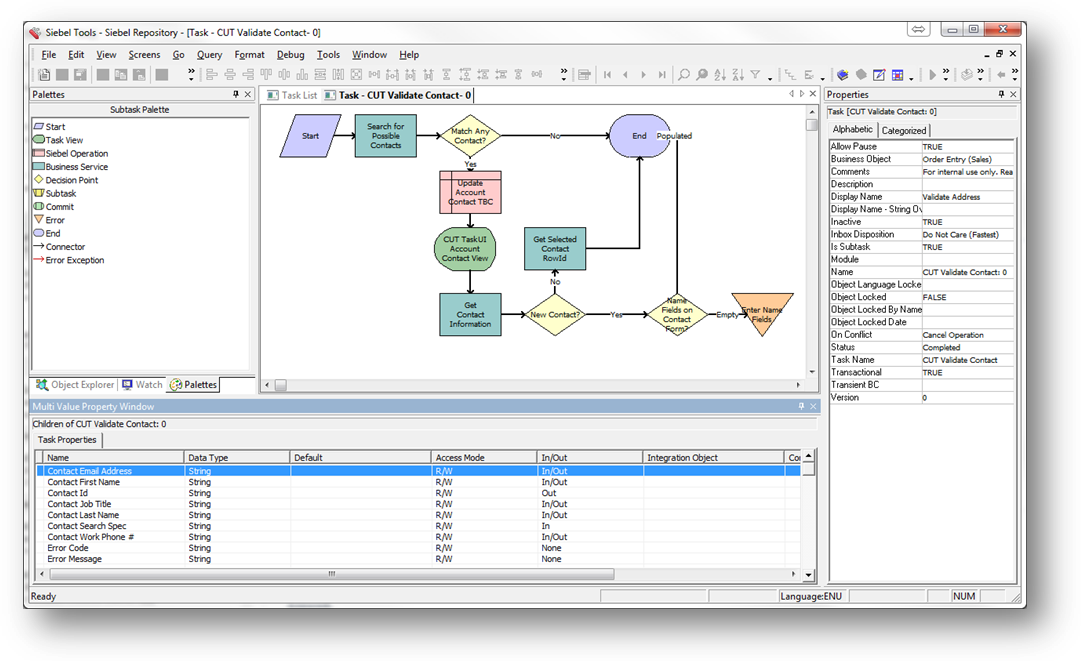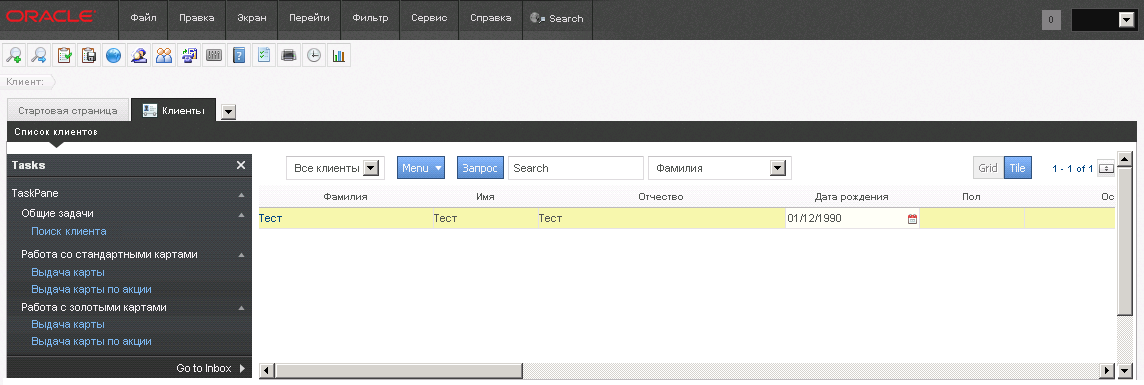Automation of business processes for working with loyalty cards
In this article we want to share the experience of implementing Siebel Loyalty program management system based on Oracle Siebel CRM for a large retail network of stores.
The main functional requirements for the system:
And we will focus on one of the requirements - automating business processes for managing loyalty cards.
Customer service on working with loyalty cards deals with the company's Service Center. All actions performed on the map by employees must be recorded in the CRM system.
')
Business processes for working with cards are divided into the following types:
Due to the fact that the company’s loyalty program uses several types of cards (standard, gold, etc.), for each of them it was necessary to create a separate process in the system. Card issuing procedures are also subdivided into several types: for example, a card can be issued for different promotions, and for each case business processes differ.
To automate the described processes, it was decided to use the Siebel Task UI.
Unlike the standard interface of Oracle Siebel CRM, Task (Task) are a set of screens, consistently arranged in accordance with the logic of the business process. Due to this, the user does not need additional qualifications, and checks and data cleaning systems reduce the likelihood of input errors, thereby ensuring the quality of the stored data in the database.
While using the task, the operator can navigate forward and backward through the screens, as well as the process suspension function. Paired tasks are placed in the Inbox folder, with the option to return to their execution later, or reassign to another system user.
The main advantage of Siebel Task UI is transactionality. The data that the user enters during the session of the task is stored in temporary tables. Writing to the database occurs at the completion of the task, or when passing through certain stages of the process. Up to this point, all changes are not available to other users. In case of cancellation of the task, the data is deleted.
Another advantage of the Siebel Task UI is the “visual” development process, which in most situations does not require the use of scripts. In the case of a minor refinement of logic, there is no need to compile the changes and, as a result, to restart the server.

These features have greatly simplified the support for existing functionality.
As a entry point for all processes, use the task "Search Client". Search is carried out by various parameters, such as card number, full name, phone number, etc. After the client is found, it becomes possible to use the remaining tasks.
In accordance with the requirements of the customer, the operator should only display the tasks available for the selected card type. For this purpose, separate screens have been developed, on each of which corresponding groups of tasks are available.
In addition, the so-called “common” group is available on all screens, using which we can at any time re-search the client or change the personal data of the client found earlier.

When changing the owner or blocking / unblocking the card, these operations are recorded using the audit function, as a result of which we see when and by whom the changes were made, as well as the initial values of the fields.
To ensure the quality of the client's personal data (Data Quality), another software product was used. When saving data in the database, a request is made to a remote system, the result of which are “cleared” full name, email and client phone number. If the data is not available in the directory, no changes are made, and the questionnaire is marked with the appropriate quality code (“Requires verification”). When entering addresses, KLADR directories are used, which also excludes the possibility of entering a non-existent address.

One of the features of business processes is the transfer of points from card to card. For example, in the case of a replacement card, the transfer of points from an old card to a new one should occur. When locking a card, the balance must be adjusted to reflect the points accumulated directly on this card.
Following the basic concept of the Siebel Loyalty module, the card balance is a set of points accrual / write-offs; therefore, all actions to change the balance are carried out by several transactions: separate for each type of points.
The second feature is the recalculation of birthday bonuses - these are points that a customer can use in a certain period (before and after the birthday), then they are reset. In case of a change in the cardholder or a change in the date of birth of the owner, the size of the available bonuses should be recalculated based on the new date. In this case, a situation may occur in which the client received a new card for the period of “accumulation” of points. In this case, the balance of the old card must also be taken into account when recalculating.

In the future, as the development of the system, it is planned to implement the Contact Center on the basis of a CRM system. Appeals of users will be recorded by operators in the form of service requests and assigned to the staff of the service center. When using the tasks described above, service requests will also be created, thus we will receive complete statistics on customer service in the most convenient way.
The main functional requirements for the system:
- Calculation of discounts, the use of price promotions
- Check processing (accrual / debit points)
- Automation of loyalty card management processes
- Maintain customer base
- Marketing campaigns
And we will focus on one of the requirements - automating business processes for managing loyalty cards.
Customer service on working with loyalty cards deals with the company's Service Center. All actions performed on the map by employees must be recorded in the CRM system.
')
Business processes for working with cards are divided into the following types:
- Customer search
- Change customer data
- Issuing a card
- Card replacement
- Change card holder
- Card lock
Due to the fact that the company’s loyalty program uses several types of cards (standard, gold, etc.), for each of them it was necessary to create a separate process in the system. Card issuing procedures are also subdivided into several types: for example, a card can be issued for different promotions, and for each case business processes differ.
To automate the described processes, it was decided to use the Siebel Task UI.
Unlike the standard interface of Oracle Siebel CRM, Task (Task) are a set of screens, consistently arranged in accordance with the logic of the business process. Due to this, the user does not need additional qualifications, and checks and data cleaning systems reduce the likelihood of input errors, thereby ensuring the quality of the stored data in the database.
While using the task, the operator can navigate forward and backward through the screens, as well as the process suspension function. Paired tasks are placed in the Inbox folder, with the option to return to their execution later, or reassign to another system user.
The main advantage of Siebel Task UI is transactionality. The data that the user enters during the session of the task is stored in temporary tables. Writing to the database occurs at the completion of the task, or when passing through certain stages of the process. Up to this point, all changes are not available to other users. In case of cancellation of the task, the data is deleted.
Another advantage of the Siebel Task UI is the “visual” development process, which in most situations does not require the use of scripts. In the case of a minor refinement of logic, there is no need to compile the changes and, as a result, to restart the server.

These features have greatly simplified the support for existing functionality.
As a entry point for all processes, use the task "Search Client". Search is carried out by various parameters, such as card number, full name, phone number, etc. After the client is found, it becomes possible to use the remaining tasks.
In accordance with the requirements of the customer, the operator should only display the tasks available for the selected card type. For this purpose, separate screens have been developed, on each of which corresponding groups of tasks are available.
In addition, the so-called “common” group is available on all screens, using which we can at any time re-search the client or change the personal data of the client found earlier.

When changing the owner or blocking / unblocking the card, these operations are recorded using the audit function, as a result of which we see when and by whom the changes were made, as well as the initial values of the fields.
To ensure the quality of the client's personal data (Data Quality), another software product was used. When saving data in the database, a request is made to a remote system, the result of which are “cleared” full name, email and client phone number. If the data is not available in the directory, no changes are made, and the questionnaire is marked with the appropriate quality code (“Requires verification”). When entering addresses, KLADR directories are used, which also excludes the possibility of entering a non-existent address.

One of the features of business processes is the transfer of points from card to card. For example, in the case of a replacement card, the transfer of points from an old card to a new one should occur. When locking a card, the balance must be adjusted to reflect the points accumulated directly on this card.
Following the basic concept of the Siebel Loyalty module, the card balance is a set of points accrual / write-offs; therefore, all actions to change the balance are carried out by several transactions: separate for each type of points.
The second feature is the recalculation of birthday bonuses - these are points that a customer can use in a certain period (before and after the birthday), then they are reset. In case of a change in the cardholder or a change in the date of birth of the owner, the size of the available bonuses should be recalculated based on the new date. In this case, a situation may occur in which the client received a new card for the period of “accumulation” of points. In this case, the balance of the old card must also be taken into account when recalculating.

In the future, as the development of the system, it is planned to implement the Contact Center on the basis of a CRM system. Appeals of users will be recorded by operators in the form of service requests and assigned to the staff of the service center. When using the tasks described above, service requests will also be created, thus we will receive complete statistics on customer service in the most convenient way.
Source: https://habr.com/ru/post/237675/
All Articles